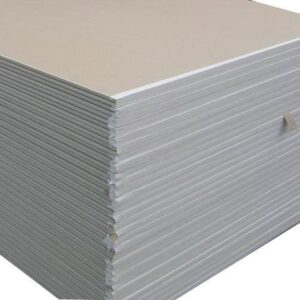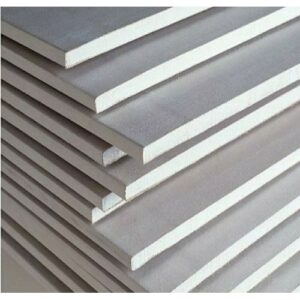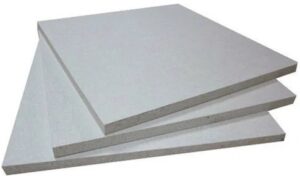BIS Certification of Gypsum Plaster Boards, Ceilings Tiles and Glass Fibre Reinforced Gypsum Panels as per IS 2095 (PART 1, 2 &3), IS 17400
In the realm of construction materials, gypsum plaster boards have emerged as a versatile and indispensable component, revolutionizing the way interior walls and ceilings are constructed. With advancements in technology and evolving standards, gypsum plaster boards have undergone significant transformations to meet the stringent requirements outlined by the Bureau of Indian Standards (BIS). This article delves into the various types of gypsum plaster boards conforming to BIS standards, with a focus on Glass Fibre Reinforced Gypsum Panels, Coated/Laminated Gypsum Plaster Boards, and Reinforced Gypsum Plaster Boards, while also shedding light on the pivotal role played by Omega QMS Pvt Ltd in obtaining BIS certification.
INDIAN STANDARDS
IS 2095 (PART 1):2023 GYPSUM PLASTER BOARDS PART 1 PLAIN GYPSUM PLASTER BOARDS
 IS 2095 (Part 1) lays down the requirements for plain gypsum plaster board intended to be used for drywall (partition), ceiling and wall lining, and panelling in buildings. It includes boards manufactured to receive either direct surface decoration or gypsum plaster finishes.. Gypsum (natural gypsum or by product gypsum) is used for making the gypsum plaster. Suitable additives like glass fibres, silicon oil and other ingredients may be added as appropriate to achieve the specific performance/quality requirement of the end product. Strong durable paper liners shall be used for lining purpose. The paper liner shall have minimum grammage per square metre is 150 g/m². Density, Flexural Breaking Load, Impact Resistance, Surface Hardness, Loading Capability, Water Absorption, Fire Resistance and finish are some of the requirements specified for gypsum plain boards.
IS 2095 (Part 1) lays down the requirements for plain gypsum plaster board intended to be used for drywall (partition), ceiling and wall lining, and panelling in buildings. It includes boards manufactured to receive either direct surface decoration or gypsum plaster finishes.. Gypsum (natural gypsum or by product gypsum) is used for making the gypsum plaster. Suitable additives like glass fibres, silicon oil and other ingredients may be added as appropriate to achieve the specific performance/quality requirement of the end product. Strong durable paper liners shall be used for lining purpose. The paper liner shall have minimum grammage per square metre is 150 g/m². Density, Flexural Breaking Load, Impact Resistance, Surface Hardness, Loading Capability, Water Absorption, Fire Resistance and finish are some of the requirements specified for gypsum plain boards.
IS 2095 (PART 2): 2022 GYPSUM PLASTER BOARDS PART 2 COATED/LAMINATED GYPSUM PLASTER BOARDS
 IS 2095 (Part 2) lays down the requirements for coated/laminated gypsum plaster boards intended to be used for drywall (partition), ceiling and wall lining, and panelling in buildings. Gypsum (natural gypsum or by-product gypsum) used for the manufacture of gypsum plaster board shall comply with the requirements of CaSO4, Free water, pH, SiO2 and chloride content. The reinforcing fibre may be cellulosic fibre produced out of waste paper like newspaper, magazines, old card boards and corrugated cartons containing cellulose. Suitable additives like glass fibres, silicon oil and other ingredients may be added as appropriate to achieve the specific performance/quality requirement of the end product. Wood veneers, plastic films, paper, etc should be used for lamination/coating on gypsum plaster board.. In these boards, the cellulosic fibres produced from the waste paper are intimately blended/embedded in the gypsum mass. The waste paper is processed in the fibre mills to form cellulosic fibres. The gypsum plaster and the cellulosic fibres are fed into a mixer to form uniformly blended mass. The mixture of gypsum plaster and the fibres are transported to a spreading unit wherein the mixture is evenly spread over a perforated belt or moulds and humidified. A continuous or hand press may be used to press the gypsum fibre mix to form gypsum fibre boards. After setting, the boards are demoulded and dried. For smooth demoulding oil or grease may be used. The board is moistened with a bonding agent for surface treatment and retarded water absorption and anti-dust properties are realized. This corresponds to a prime coating effected in the factory for a painting or lamination/ papering. The board is now finished and can be packed and stacked. Density, Flexural Breaking Load, Fire Resistance and finish are some of the requirements specified for gypsum plain boards.
IS 2095 (Part 2) lays down the requirements for coated/laminated gypsum plaster boards intended to be used for drywall (partition), ceiling and wall lining, and panelling in buildings. Gypsum (natural gypsum or by-product gypsum) used for the manufacture of gypsum plaster board shall comply with the requirements of CaSO4, Free water, pH, SiO2 and chloride content. The reinforcing fibre may be cellulosic fibre produced out of waste paper like newspaper, magazines, old card boards and corrugated cartons containing cellulose. Suitable additives like glass fibres, silicon oil and other ingredients may be added as appropriate to achieve the specific performance/quality requirement of the end product. Wood veneers, plastic films, paper, etc should be used for lamination/coating on gypsum plaster board.. In these boards, the cellulosic fibres produced from the waste paper are intimately blended/embedded in the gypsum mass. The waste paper is processed in the fibre mills to form cellulosic fibres. The gypsum plaster and the cellulosic fibres are fed into a mixer to form uniformly blended mass. The mixture of gypsum plaster and the fibres are transported to a spreading unit wherein the mixture is evenly spread over a perforated belt or moulds and humidified. A continuous or hand press may be used to press the gypsum fibre mix to form gypsum fibre boards. After setting, the boards are demoulded and dried. For smooth demoulding oil or grease may be used. The board is moistened with a bonding agent for surface treatment and retarded water absorption and anti-dust properties are realized. This corresponds to a prime coating effected in the factory for a painting or lamination/ papering. The board is now finished and can be packed and stacked. Density, Flexural Breaking Load, Fire Resistance and finish are some of the requirements specified for gypsum plain boards.
IS 2095 (PART 3):2022 GYPSUM PLASTER BOARDS PART 3 REINFORCED GYPSUM PLASTER BOARDS TILES CORNICES AND MOULDINGS
 IS 2095 (Part 3):2022 covers manufacture, requirements, tests and method of sampling for the following gypsum plaster units: a) Fibre reinforced gypsum plaster units; and b) Glass reinforced gypsum (GRG) plaster units. 1.2 The gypsum plaster units comprise boards and tiles. Boards are mainly used as a lining material for ceiling, dry surfacing material for walls, door panels or for partitions. Tiles are mainly used as material for making false ceilings. Gypsum (natural gypsum or by-product gypsum) used for the manufacture of gypsum plaster board shall comply with the requirements of CaSO4, Free water, pH, SiO2 and chloride content. The reinforcing fibre may be sisal, coconut, jute or other fibres or their combination. These shall be thoroughly teased and free from dust, grease or other substances likely to affect strength of the fibrous plaster boards. The reinforcing fibre shall be E type glass roving having good chopping characteristics and dispersibility. For tiles, the length of glass fibre should be of 15 mm to 45 mm. Density, Flexural Breaking Load, Impact Resistance, Water Absorption and finish are some of the requirements specified for gypsum plain boards.
IS 2095 (Part 3):2022 covers manufacture, requirements, tests and method of sampling for the following gypsum plaster units: a) Fibre reinforced gypsum plaster units; and b) Glass reinforced gypsum (GRG) plaster units. 1.2 The gypsum plaster units comprise boards and tiles. Boards are mainly used as a lining material for ceiling, dry surfacing material for walls, door panels or for partitions. Tiles are mainly used as material for making false ceilings. Gypsum (natural gypsum or by-product gypsum) used for the manufacture of gypsum plaster board shall comply with the requirements of CaSO4, Free water, pH, SiO2 and chloride content. The reinforcing fibre may be sisal, coconut, jute or other fibres or their combination. These shall be thoroughly teased and free from dust, grease or other substances likely to affect strength of the fibrous plaster boards. The reinforcing fibre shall be E type glass roving having good chopping characteristics and dispersibility. For tiles, the length of glass fibre should be of 15 mm to 45 mm. Density, Flexural Breaking Load, Impact Resistance, Water Absorption and finish are some of the requirements specified for gypsum plain boards.
IS 17400:2021 GLASS FIBRE REINFORCED GYPSUM PANELS
 This standard specifies constituent materials, dimensions and physical requirements, test methods, packaging and transportation requirements of glass fibre reinforced gypsum (GFRG) building panels, for building construction. GFRG panels shall be supplied in following classes: Class 1 : To be used for load-bearing structural elements, like, walls and slabs/roofs. Class 2 : To be used for non load-bearing elements, like, internal partition/boundary walls. Glass fibre rovings used shall be E Glass rovings with a diameter of 13 ± 2 µm, tensile breaking load of 470 N, Min. Water content, Panel mass, Water absorption, Vertical Load bearing capacity, Out-of-plane moment capacity, Moh’s hardness, Fire resistance (structural adequacy/ integrity/insulation), Glass Fibre content are some of the requirements stated for glass fibre reinforced gypsum panels.
This standard specifies constituent materials, dimensions and physical requirements, test methods, packaging and transportation requirements of glass fibre reinforced gypsum (GFRG) building panels, for building construction. GFRG panels shall be supplied in following classes: Class 1 : To be used for load-bearing structural elements, like, walls and slabs/roofs. Class 2 : To be used for non load-bearing elements, like, internal partition/boundary walls. Glass fibre rovings used shall be E Glass rovings with a diameter of 13 ± 2 µm, tensile breaking load of 470 N, Min. Water content, Panel mass, Water absorption, Vertical Load bearing capacity, Out-of-plane moment capacity, Moh’s hardness, Fire resistance (structural adequacy/ integrity/insulation), Glass Fibre content are some of the requirements stated for glass fibre reinforced gypsum panels.
QUALITY CONTROL ORDER (TECHNICAL REGULATION) ISSUED BY THE DEPARTMENT FOR PROMOTION OF INDUSTRY AND INTERNAL TRADE, MINISTRY OF COMMERCE AND INDUSTRY, GOVT. OF INDIA ON 06 MARCH 2024 FOR MANDATORY BIS CERTIFICATION
The DPIIT, Ministry of Commerce & Industry, Govt. of India, has issued an order, making it mandatory for all gypsum products mentioned above to be used in India, whether manufactured in India or imported from foreign countries, shall mandatorily carry the Standard Mark of the Bureau of Indian Standards under a valid BIS licence. In short, it has become obligatory for all the manufacturers of gypsum products mentioned above, whether in India or overseas, to immediately apply for BIS licence and obtain a valid BIS certification licence before that the last date of implementation of the order, i.e., 05 September 2024.
BIS CERTIFICATION SCHEME
The BIS Standards mentioned above establish a comprehensive framework encompassing various quality parameters that gypsum products must adhere to. The Bureau of Indian Standards Certification Scheme is a vital framework established by the Indian government to ensure the quality, safety, and reliability of products available in the market. This scheme aims to safeguard consumer interests by setting stringent benchmarks and guidelines that products must meet before they can be deemed compliant. BIS certification covers a wide range of industries and products, encompassing the entire gamut of industrial and manufacturing activity. Various steps involved in the BIS Certification process are enumerated below:
- Standard Identification: Manufacturers identify the relevant BIS standard that applies to their chosen product category. These standards outline the specific quality, safety, and performance requirements that the product must meet.
- Application Submission: Manufacturers submit an application for BIS certification to the Bureau of Indian Standards (BIS), providing details about the product, its specifications, and the desired certification mark.
- Factory Inspection: BIS conducts an inspection of the manufacturer’s production facility to assess the quality control processes, infrastructure, and adherence to relevant standards.
- Sample Testing: BIS collects samples of the product from the manufacturer for testing in authorized BIS laboratories or recognized testing centers. These tests evaluate various parameters specified by the BIS standard.
- Certification Decision: Based on the satisfactory test results and compliance with standards, BIS decides whether to grant certification to the product. If approved, the manufacturer is issued a BIS certification license.
- Regular Monitoring: BIS monitors the manufacturing process of certified products through periodic audits and market surveillance to ensure ongoing compliance with quality control processes and standards.
OMEGA QMS PVT. LTD. – PARTNERING FOR SUCCESS
In the pursuit of achieving BIS certification and maintaining the highest levels of product quality, Omega QMS Pvt. Ltd. emerges as an invaluable partner for manufacturers. Backed by a global presence and a stellar track record of successful collaborations with Fortune 500 companies, Omega QMS provides an extensive array of services designed to streamline the certification process and ensure compliance with industry standards.
- Expert Guidance: Omega brings together a team of seasoned experts who possess in-depth knowledge of regulatory requirements, industry best practices, and intricacies of certification process. These experts guide manufacturers through the complex landscape, offering insights and strategies to navigate the process efficiently.
- Testing and Validation: Omega assists manufacturers in planning and executing necessary tests and validations required for BIS certification.
- Documentation and Compliance: The journey toward BIS certification demands meticulous documentation of processes, materials, and testing procedures. Omega aids manufacturers in creating comprehensive and accurate documentation that aligns with BIS requirements, reducing the risk of errors and rejections.
- Audit Support: Omega prepares manufacturers for BIS audits, which are a crucial part of the certification process. With its expertise, the organization ensures that manufacturers are well-prepared for audits, addressing any issues that may arise and increasing the likelihood of a successful outcome.
- Customized Approach: Each manufacturer’s journey toward BIS certification is unique. Omega understands this and tailors its services to fit the specific needs, challenges, and goals of individual manufacturers, ensuring a personalized and effective approach.
- Global Experience: With presence in over 40 countries, Omega brings global experience to the table. This international exposure allows the organization to offer insights into varying regulatory environments and industry practices, enabling manufacturers to excel globally.
Omega QMS Pvt. Ltd. functions as a strategic partner for manufacturers aiming to achieve BIS Certification. Its multifaceted approach encompasses expert guidance, process control, testing and validation support, documentation assistance, audit preparation, training, and a global perspective. By collaborating with Omega, manufacturers gain a competitive edge in their pursuit of certification while upholding the highest standards of product quality and consumer satisfaction.
For more details you can reach out to Omega at info@globalomega.com
In conclusion, the evolution of gypsum plaster boards in accordance with BIS standards underscores the commitment of the construction industry towards innovation, sustainability, and quality assurance. From traditional gypsum boards to advanced GFRG panels and coated/laminated variants, these materials continue to shape modern architectural landscapes while adhering to stringent regulatory requirements. With Omega QMS Pvt Ltd as a trusted partner, manufacturers can navigate the complexities of BIS certification seamlessly, ensuring compliance, competitiveness, and customer satisfaction in an ever-evolving market scenario.

Leave a Reply